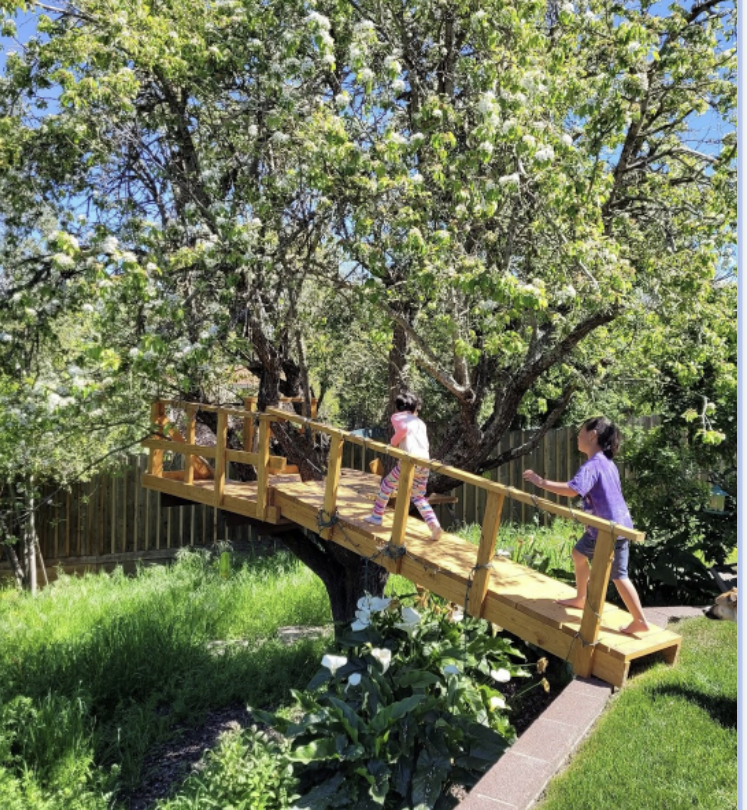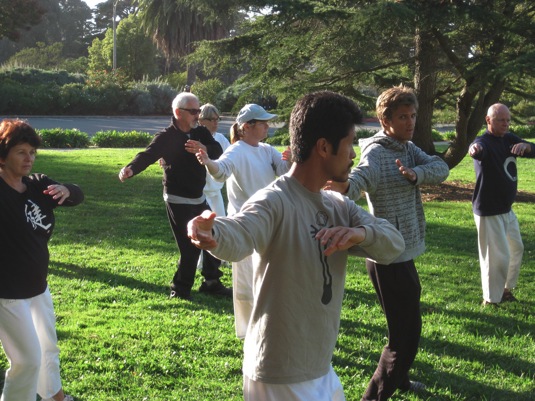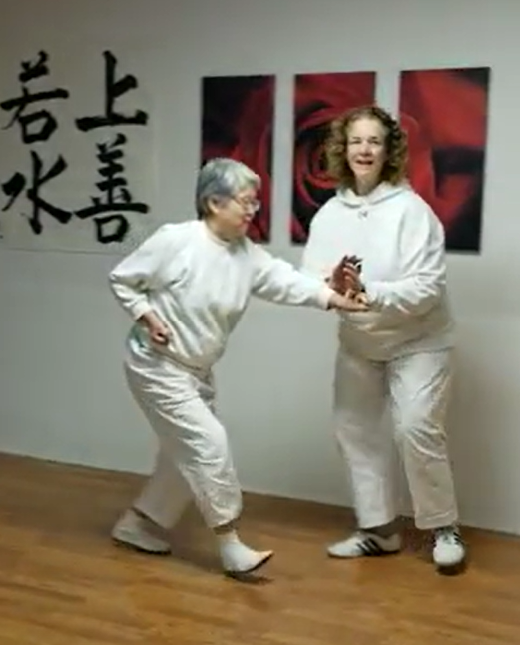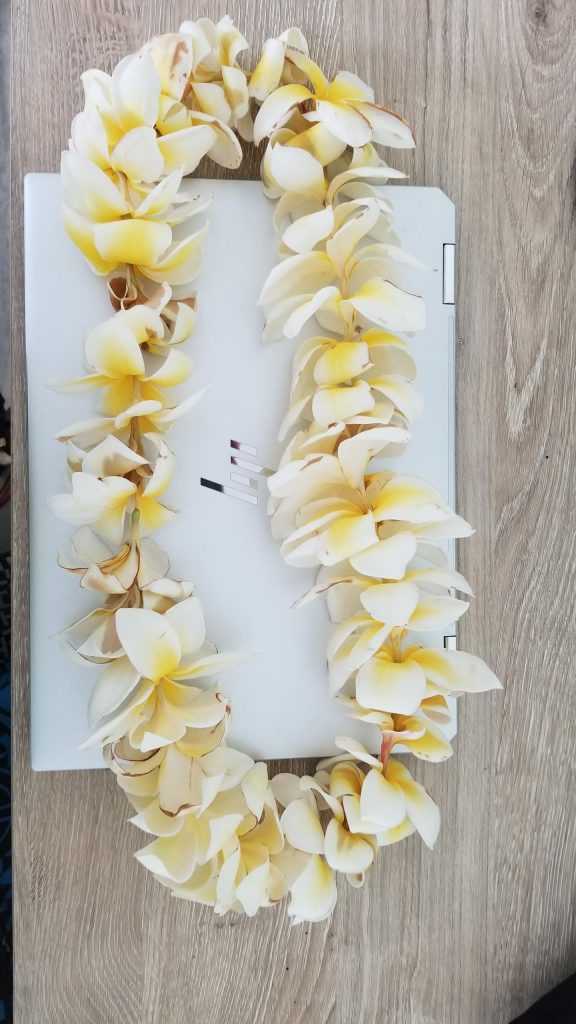Feelings of Grief

by Connie Borden, 9 March 2022
en français ci-dessous / 以下日本語で
Introduction
Tomi Nagai-Rothe and Connie Borden, both Shintaido Instructors, are also active with HF Ito, Sarah Baker, Rob Gaston and many others in the Global Taimyo Community (GTC). GTC formed after September 11 in 2001 and re-formed on the 20th anniversary in 2021. GTC believes that Taimyo Kata can function like a ritual form through which we can search and/or heal our inner world as well create better relationships with our outer world — including neighbors, community, and Nature.
This is the second of two articles written for the 2022 gatherings on the theme of Kintsugi (金継ぎ, “golden joinery”), also known as kintsukuroi (金繕い, “golden repair”). Mending is one way to transform objects and ourselves. Yet before we can mend or make amends, we need to feel the brokenness fully, be it a personal weakness or the violence of war. Deeply feeling the brokenness is a personal responsibility and a collective responsibility that is painful and necessary.
These articles were written to help open conversations. Our hope is to create a brave space rather than a “safe space.” The keiko analogy would be a perspective-altering kirioroshi kumite as opposed to an enjoyable keiko where you leave the same way as you arrived. It’s not that we feel unsafe in an incredible kirioroshi kumite – quite the contrary – we feel so safe with our partner that we can open ourselves to them.
Please reflect and share your comments on these articles being shared with the Shintaido audience via Body Dialogue.
My understanding of feelings of grief and loss stem from my experience working in the hospice field starting in 1994 and the death of my father in 1998. Later my professional experience expanded into palliative and hospice care.
Each person is different, and feelings of grief can vary in intensity. Feelings of grief and grieving can be cyclical. This process can often feel like one step forward and two steps back. Anniversaries and special occasions can bring back these feelings of grief.
Photo by Cynthia Derosier
What have I experienced? The first step was becoming vulnerable enough to experience these emotions. It’s much easier to deflect and deny them. Due to our fear of being controlled by our emotions, it is common to hide these feelings. My own experience at my father’s death was numbness. I recall seeing a poster showing faces of 32 emotions. I could only identify two or three of the emotions at that time. I was that numb. Over time through therapy and doing more Shintaido, I could also experience anger, sadness and gradually remembering more of the many facets of my father’s life.
Perhaps you remember something similar? Perhaps you too can recall the impact of opening your hands, opening your body and then opening your mind through Shintaido movements? And did you wonder what was happening? I believe these movements of raising our arms overhead, opening the center of our body and using our voices can result in feelings of vulnerability.
How did I experience doing some of these movements? The first was centering, finding where I feel my emotions, where I hold tension, where I block to avoid joining with others. One way to center is the seated, rocking motion where we rock from one hip to the other hip. Rocking itself is soothing. Rocking side to side draws our attention to where the center of our being is and when we are off center. Being centered, I could be aware of my emotions, thoughts and feelings. Another movement was raising my arms overhead and relaxing to allow my partner to cut me during Tenshingoso kumite. As I opened my arms overhead, leaned backwards from my center and received the overhead cut, I found my center – often the heart area – being opened. This life exchange of energy through kirioroshi kumite can be supportive as each person is cut and then cuts their partner. When I opened and was cut, I was then softer and more receptive to the energies of the environment. This cathartic type of movement allowed me to cry. Early in my practice at gasshukus amongst the beautiful, strong, enduring redwood trees. I would find myself crying and hugging the redwood trees. At another gasshuku on Ocean Beach with sand below my feet, I found myself crying when being cut and rolled. Over time these reactions to being opened during practice have been less startling, and more familiar so I can say “Oh this is happening again, what can I learn from this?”
Photo by Tomi Nagai-Rothe
Death is one of the most obvious reasons for grief. What else might constitute times of grief from loss? Sometimes it comes with the diagnosis of a medical condition that results in loss of physical mobility. At other times it might be from a change in a significant relationship with resulting feelings of loss of a promised future. A job loss, change in a living situation or a loss of income are others. Even what we consider to be happy events – a child’s high school graduation or a marriage – can bring tears that are a mixture of happiness and sadness. These emotions seem to reflect a clear demarcation of a change we are experiencing from one state of being to another state of being.
What are some ways people can begin to acknowledge feelings? For some it is focused talk therapy, for others journaling, for others listening to music, and for others doing art, gardening, or body movement. Where and how to acknowledge feelings with others is also critical. Where and how require a space that provides love and is non-judgmental. One of the common experiences for a person who has had a recent event such as death is they report that people grow tired of hearing about their loss. Some people find it helpful to join a focused support group on loss, such as a bereavement group. For others, the sacred space of a dojo provides the place to explore and acknowledge feelings, thoughts and emotions.
Suffering is present for us all. I am reminded of the saying “be gentle with others, you do not know what they are experiencing.” To open and be aware of one’s emotions including grief, anger, and sadness, is the first step. Sharing with others as a next step keeps us human and open. These upcoming Global Taimyo Community gatherings can be one place to practice vulnerability. Our gatherings can be a place to gather, to build peace within ourselves and to support each other by being in community. Our gatherings can be a community to foster mending and finding ourselves more human.
Les sentiments de deuil
par Connie Borden
9 mars 2022
Ma compréhension des sentiments de deuil et de perte provient de mon expérience de travail dans le domaine des soins palliatifs depuis 1994 et du décès de mon père en 1998. Plus tard, mon expérience professionnelle s’est étendue aux soins palliatifs et aux soins en hospice.
Chaque personne est différente, et les sentiments de deuil peuvent varier en intensité. Les sentiments de chagrin et de deuil peuvent être cycliques. Ce processus peut souvent donner l’impression d’un pas en avant et de deux pas en arrière. Les anniversaires et les occasions spéciales peuvent faire resurgir ces sentiments de deuil.
Qu’est-ce que j’ai vécu ? La première étape a été de devenir suffisamment vulnérable pour vivre ces émotions. Il est beaucoup plus facile de les détourner et de les nier. Par peur d’être contrôlé par nos émotions, il est courant de cacher ces sentiments. Lors du décès de mon père, j’ai moi-même ressenti un engourdissement. Je me souviens avoir vu une affiche montrant les visages de 32 émotions. Je ne pouvais identifier que deux ou trois de ces émotions à ce moment-là. J’étais à ce point engourdie. Avec le temps, grâce à la thérapie et à la pratique du Shintaido, j’ai pu ressentir de la colère, de la tristesse et, progressivement, me souvenir des nombreuses facettes de la vie de mon père.
Peut-être vous souvenez-vous de quelque chose de similaire ? Peut-être vous souvenez-vous aussi de l’impact de l’ouverture des mains, de l’ouverture du corps et de l’ouverture de l’esprit par les mouvements du Shintaido ? Et vous êtes-vous demandé ce qui se passait ? Je crois que ces mouvements consistant à lever les bras au-dessus de la tête, à ouvrir le centre de notre corps et à utiliser notre voix peuvent entraîner des sentiments de vulnérabilité.
Comment ai-je vécu l’exécution de certains de ces mouvements ? Tout d’abord, en me centrant, en trouvant où je ressens mes émotions, où je maintiens des tensions, où je bloque pour éviter de me joindre aux autres. L’une des façons de se centrer est le mouvement de balancement assis, où l’on se balance d’une hanche à l’autre. Le balancement en soi est apaisant. Se balancer d’un côté à l’autre attire notre attention sur l’endroit où se trouve le centre de notre être et sur les moments où nous sommes décentrés. En étant centrée, je pouvais être consciente de mes émotions, de mes pensées et de mes sentiments. Un autre mouvement consistait à lever les bras au-dessus de ma tête et à me détendre pour permettre à mon partenaire de me couper pendant le Tenshingoso kumite. Lorsque j’ouvrais les bras au-dessus de ma tête, que je me penchais vers l’arrière à partir de mon centre et que je recevais la coupe au-dessus de ma tête, je découvrais que mon centre – souvent la région du cœur – était ouvert. Cet échange d’énergie vitale à travers le kumite kirioroshi peut être un soutien car chaque personne est coupée et coupe ensuite son partenaire. Lorsque je me suis ouverte et que j’ai été coupée, j’étais alors plus douce et plus réceptive aux énergies de l’environnement. Ce type de mouvement cathartique m’a permis de pleurer. Au début de ma pratique à Gasshukus, parmi les beaux, forts et durables séquoias. Je me surprenais à pleurer et à étreindre les séquoias. Dans un autre gasshuku sur Ocean Beach, avec du sable sous les pieds, je me suis retrouvée à pleurer quand on me coupait et me roulait. Au fil du temps, ces réactions à l’ouverture pendant la pratique sont devenues moins surprenantes et plus familières, ce qui me permet de dire : “Oh, cela se reproduit, qu’est-ce que je peux apprendre de cela ?”.
La mort est l’une des raisons les plus évidentes du deuil. Qu’est-ce qui pourrait constituer d’autres moments de deuil à cause d’une perte ? Parfois, il s’agit du diagnostic d’un problème médical qui entraîne une perte de mobilité physique. Dans d’autres cas, il peut s’agir d’un changement dans une relation importante, qui entraîne un sentiment de perte d’un avenir promis. Une perte d’emploi, un changement dans les conditions de vie ou une perte de revenus en sont d’autres. Même ce que nous considérons comme des événements heureux – l’obtention du diplôme d’études secondaires d’un enfant ou un mariage – peut provoquer des larmes qui sont un mélange de de bonheur et de tristesse. Ces émotions semblent refléter une démarcation claire d’un changement que nous vivons d’un état d’être à un autre état d’être.
De quelle manière les gens peuvent-ils commencer à reconnaître leurs sentiments ? Pour certains, il s’agit d’une thérapie par la parole, pour d’autres de la tenue d’un journal, pour d’autres encore d’écouter de la musique, et pour d’autres de faire de l’art, du jardinage ou des mouvements corporels. Le lieu et la manière de reconnaître ses sentiments avec les autres sont également essentiels. L’endroit et la manière nécessitent un espace qui offre de l’amour et ne porte pas de jugement. L’une des expériences les plus courantes pour une personne qui a vécu un événement récent comme un décès est que les gens se lassent d’entendre parler de leur perte. Certaines personnes trouvent utile de se joindre à un groupe de soutien axé sur la perte, comme un groupe de soutien aux personnes en deuil. Pour d’autres, l’espace sacré d’un dojo permet d’explorer et de reconnaître les sentiments, les pensées et les émotions.
La souffrance est présente pour nous tous. Je me souviens du dicton “soyez doux avec les autres, vous ne savez pas ce qu’ils vivent”. S’ouvrir et prendre conscience de ses émotions, y compris le chagrin, la colère et la tristesse, est la première étape. L’étape suivante consiste à partager avec les autres, ce qui nous permet de rester humains et ouverts. Les prochains rassemblements de la communauté mondiale Taimyo peuvent être un lieu de pratique de la vulnérabilité. Nos rencontres peuvent être un lieu de rassemblement, pour construire la paix en nous-mêmes et pour nous soutenir mutuellement en étant en communauté. Nos rassemblements peuvent être une communauté qui favorise la réparation et la découverte de notre humanité.
悲しみの感情
コニー・ボーデン著
2022年3月9日
悲しみや喪失感についての私の理解は、1994年からホスピスで働いた経験と、1998年の父の死からきています。その後、私の職業経験は緩和ケアとホスピスケアに広がりました。
人はそれぞれ異なり、悲しみの感情も強弱があります。悲しみの感情や悲嘆は循環していることがあります。このプロセスは、しばしば一歩進んで二歩下がるように感じられることがあります。記念日や特別な日には、このような悲しみの感情がよみがえることがあります。
私は何を経験したのでしょうか。最初のステップは、このような感情を経験できるほど無防備になることでした。そのような感情を無視したり、否定したりするのはずっと簡単なことです。感情に支配されることへの恐れから、これらの感情を隠すことはよくあることです。私自身、父の死後は無感覚でした。私は、32の感情の顔を示すポスターを見たことを思い出します。その時、私はその中の2つか3つの感情しか認識することができませんでした。それほど無感覚だったのです。やがて、セラピーや新体道を通じて、怒りや悲しみも経験できるようになり、次第に父の人生のさまざまな面を思い出すようになりました。
おそらく、あなたは同じような何かを覚えていますか?あなたも、新体道の動きによって、手を開き、体を開き、そして心を開くことの衝撃を思い出すことができるのではないでしょうか?そして、何が起こっているのか不思議に思いませんでしたか?私は、両手を上げ、体の中心を開き、声を出すという動作は、結果的に弱さを感じさせることになると考えています。
これらの動作のいくつかを行ってみて、私はどうだったでしょうか。まず、自分の感情をどこで感じているか、どこで緊張しているか、どこで他人と一緒にならないようにブロックしているかを見つける、センタリングでした。センタリングする方法のひとつに、座って片方の腰からもう片方の腰へ揺らす動きがあります。揺れること自体が癒しになります。左右に揺らすと、私たちの存在の中心がどこにあるのか、そしていつ中心から外れているのかに注意を向けることができます。中心があることで、私は自分の感情や思考、感覚に気づくことができました。もう一つの動きは、天真御祖組手において、パートナーが私を切るために腕を頭上に上げ、力を抜いたことである。両手を頭上に広げ、自分の中心から後方に傾き、頭上で切り込みを受けると、自分の中心(多くの場合、心臓のあたり)が開かれるのが分かりました。切落し組手を通してのこのような生命のエネルギーの交換は、各人が切られ、そして相手を切るというように、支え合うことができる。自分が開き、切られることで、より柔らかく、より環境のエネルギーを受け入れることができるのです。このカタルシス的な動きによって、私は泣くことができたのです。合宿所での練習の初期、美しく、強く、耐久性のあるレッドウッドの木々の中で、私は泣いていました。私は泣きながらアカギの木を抱きしめていました。また、オーシャンビーチにある合宿所では、足元に砂が広がる中、切り返されたり、転がされたりしているうちに涙があふれてきました。時間が経つにつれて、練習中に開かれたときのこれらの反応は、驚くようなものではなく、より身近なものになってきました。
死は、悲しみの最も明白な理由の一つです。では、喪失感からくる悲しみは、他にどのようなものがあるでしょうか。あるときは、病気が診断され、その結果、体が動かなくなることです。また、ある時は、重要な人間関係が変化し、約束された未来を失ったという喪失感から来るかもしれません。失業、生活環境の変化、収入の減少などもあります。子供の高校卒業や結婚など、私たちが幸せだと思う出来事でさえ、さまざまな感情が入り混じった涙を流すことがあります。
写真提供:トミ・ナガイ=ローテ
幸せと悲しみが入り混じった涙。これらの感情は、ある状態から別の状態への変化を明確に区分して反映しているように思います。
感情を認めるために、どのような方法があるのでしょうか。ある人はトークセラピーに集中し、ある人は日記を書き、ある人は音楽を聴き、ある人はアートやガーデニング、体の動かし方をします。どこで、どのように他の人と感情を認め合うかも重要です。どこで、どのようにするかというと、愛と偏見のない空間が必要です。死のような最近の出来事を経験した人に共通することのひとつは、人々が自分の喪失について聞くのにうんざりしてしまうという報告です。死別のグループなど、喪失に焦点を当てた支援グループに参加することが役に立つと感じる人もいます。また、道場の神聖な空間は、気持ち、考え、感情を探求し、認める場を提供してくれる。
苦しみは誰にでもあるものです。私は、”他人を思いやること、その人が何を経験しているかわからない “という言葉を思い出します。悲しみや怒り、喜びなど、自分の感情を開いて自覚することが、最初のステップです。次のステップとして、他者と分かち合うことで、私たちは人間らしく、オープンであり続けることができるのです。このグローバルタイミョーコミュニティーの集まりは、脆弱性を実践する一つの場となり得る。私たちの集まりは、自分自身の中に平和を築き、コミュニティに参加することでお互いをサポートする場となりえます。私たちの集まりは、修復を促進し、より人間らしい自分を見つけるためのコミュニティとなり得るのです。





